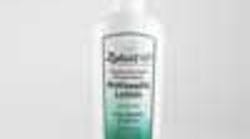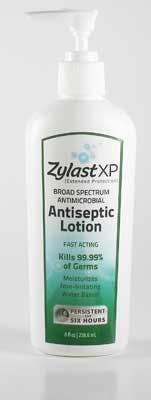Zylast products, including an alcohol-based antiseptic, a water-based antiseptic lotion, and a foaming hand soap, were tested against a range of 25 different bacteria.
The list of bacteria tested is standard, and was developed to help ensure a broad, representative spectrum of organisms was evaluated. Among the bacteria tested were E. Coli, a leading cause of food poisoning, S. Pneumoniae, a primary source of pneumonia and meningitis, and Acinetobacter baumannii, a drug-resistant bacteria that causes many fatal hospital infections and is prevalent in soldiers wounded in Iraq and Afghanistan.
Two of the most prevalent and dangerous of these drug-resistant bacteria are Methicillin-Resistant S. aureus (MRSA) and Vancomycin-Resistant Enterococci (VRE). Testing was performed with the Zylast antiseptic against both of these deadly bacteria. Not only did the antiseptic destroy more than 99.99% of these bacteria on contact, it was still killing more than 90% of VRE and MRSA one hour after it was applied.
All Zylast products have been shown to be persistent for six hours, and have demonstrated rapid, broad-spectrum kill as well. In-vitro testing on skin substitutes has shown that all Zylast products are still killing at or above 97% of disease-causing bacteria at one hour, and remaining above 90% at four hours after application.
When the Zylast Antiseptic was tested, it was shown to be more than 100 times more effective against Norovirus than alcohol alone (Liu, et al, BioScience Results). Previous testing has also been performed against the H1N1 flu, where the Zylast Antiseptic killed 99.99% of the virus within 15 seconds.
Click here for Zylast|Norovirus Reduction data graph
Innovative BioDefense, creators of Zylast, believe the combination of increased immediate kill and long-lasting persistence can significantly reduce infection rates in hospitals, nursing homes, schools, and businesses. The Zylast products were 100 times more effective than necessary to exceed the FDA Healthcare Personnel Handwash requirement, and passed the Surgical Scrub test as well.
"The Zylast line of products was developed to provide both immediate and persistent protection against germs," said Robert Sloane, MD, FACS.
"Competing alcohol sanitizers only kill bacteria until the product evaporates, after about 15 seconds. This greatly limits their effectiveness--immediately after application, hands can again become contaminated. As many bacteria become drug-resistant, hospital-acquired infections become even more dangerous--90,000 people are killed by these infections each year in the United States alone."
Studies have shown that even in hospitals, health-care workers only comply with hand hygiene protocols about 50% of the time, leaving patients vulnerable nearly half the time.
Time-kill testing is specified by the FDA, and is a laboratory test designed to determine how well, and how long, a given product eliminates bacteria. A known amount of the bacteria is put into a solution of the antimicrobial product and left for the specified time--15, 30, or 60 seconds--and then counted to determine how effective the agent was in destroying the microbe. The testing was performed by one of the foremost independent microbiology labs in the country, BioScience Laboratories.
Click here for Zylast Antiseptic-Sustained Kill data graph
A recent investigation demonstrated the shortcomings of standard alcohol sanitizers. Encompassing 91 separate facilities, the study, published in the Journal of Infection Control, showed that long-term care facilities that relied on alcohol sanitizers were six times more likely to suffer a Norovirus outbreak than those relying on handwashing alone.
Homes that used alcohol sanitizers were more likely than not to have an outbreak within the year. This can be explained by two factors: alcohol sanitizers have no persistence, and are often ineffective against viruses.
This combination of rapid, broad-spectrum kill and persistence has significant clinical importance. Using a product with persistence was shown to decrease illness-related absenteeism in elementary schools by 42% (Dyer, et al), as compared to 0-19% with alcohol alone. In a pilot hospital study of more than 6,000 patients, hospital-acquired infection rates were reduced by 44% across threee different wards using the antiseptic.
The organisms tested included:
* Acinetobacter baumannii - Drug-resistant bacteria causing severe pneumonia and bloodstream infections
* Bacteroides fragilis - Penicillin-resistant bacteria responsible for many abdominal infections
* Candida albicans - A yeast species that can produce oral and genital infection
* Candida tropicalis - A pathogenic yeast responsible for thrush infections, typically in immune-compromised patients, and growing rapidly
in worldwide prevalence
* Enterobacter aerogenes - Gram-negative bacteria responsible for a range of infections, known to mutate rapidly into drug-resistant forms
* Enterococcus faecalis - A common cause of nosocomial infection, this gram-positive bacteria can cause endocarditis, urinary tract infections, and meningitis
* Enterococcus faecium - A dangerous bacteria that can cause neonatal meningitis. It easily becomes resistant to antibiotics, and is the basis of Vancomyicin-Resistant Enteroccocus, one of the deadliest agents in hospital-acquired infections
* Escherichia coli (two versions) - One of the leading causes of food poisoning worldwide
* Haemophilus influenzae - A gram-negative bacteria that causes a wide range of infections, including lower respiratory infections in children and infants where immunizations are unavailable
* Klebsiella oxytoca - A gram-negative bacteria, particularly dangerous in hospital settings, where Klebsiella strains cause approximately 8% of all nosocomial infections
* Klebsiella pneumonia - Another gram-negative bacteria of the Klebsiella family, this bacteria causes pneumonia in elderly patients and is
particularly dangerous for alcoholics, who contract the disease at a high rate. Mortality rates among alcoholics with this infection approach 50%
* Micrococcus luteus - Typically a harmless bacteria in the hand flora, M. lutues can be responsible for infections as well, particularly in
immune-compromised patients
* Proteus mirabilis - A leading cause of kidney stones, this gram-negative bacteria can also cause wound infections and sepsis
* Pseudomonas aeruginosa (two versions) - A dangerous bacteria that thrives on medical equipment and catheters and is a major source of nosocomial infection, this gram-negative bacteria can be fatal if infecting a vital organ
* Serratia marcescens - A bacteria involved in many hospital-acquired infections, particularly due to catheters
* Staphylococcus aureus (two versions) - A common gram-positive bacteria, "staph" can manifest as minor skin infections or major, life-threatening conditions like sepsis and pneumonia. When it becomes resistant to antibiotics it becomes MRSA, one of the most feared and deadly nosocomial infections
* Staphylococcus epidermidis - Can cause infection in immune-compromised patients and in conjunction with catheter use
* Staphylococcus haemolyticus - A common gram-positive bacteria that can be responsible for minor, localized infection or dangerous systemic infection
* Staphylococcus hominis - A gram-positive bacteria, potentially dangerous for immune-compromised patients
* Staphylococcus saprophyticus - A standard cause of urinary tract infections
* Streptococcus pneumoniae - A major cause of not only pneumonia, but sinus infections, meningitis, sepsis, and endocarditis
* Streptococcus pyogenes - This gram-positive bacteria is the cause of many infections, including strep throat. It can lead to dangerous,
systemic infections that have a 25% mortality rate. It is estimated this bacteria causes at least 150,000 deaths annually
For more informaiton, visit www.zylast.com.
To comment on this subject, go to http://community.pennwelldentalgroup.com.







